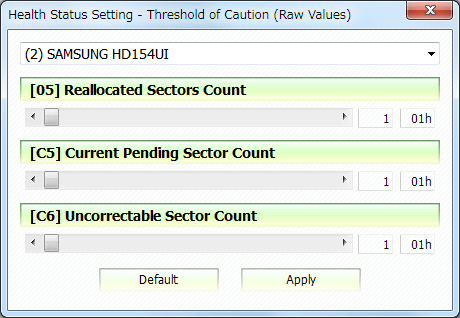

- #CRYSTALDISKINFO CAUTION CURRENT PENDING SECTOR COUNT 100 INSTALL#
- #CRYSTALDISKINFO CAUTION CURRENT PENDING SECTOR COUNT 100 DRIVERS#
- #CRYSTALDISKINFO CAUTION CURRENT PENDING SECTOR COUNT 100 UPDATE#
- #CRYSTALDISKINFO CAUTION CURRENT PENDING SECTOR COUNT 100 DOWNLOAD#
Start-Process "$($Env:ProgramFiles)\CrystalDiskInfo\DiskInfo64.exe" -ArgumentList "/CopyExit" -wait
#CRYSTALDISKINFO CAUTION CURRENT PENDING SECTOR COUNT 100 INSTALL#
So first You install the CrystalDiskInfo, create a new PS scanner and run this: My aim is to create a Powershell scanner, that would run the previously installed CrystalDiskInfo in the CopyExit mode so that it spits out the output (done successfully) and parse the output into the columns in PDQ Inventory PS scanner output (this part I cannot do). So I decided to act on this problem and want to use the reliable SMART analysis as the users' data are at risk and we do not know about it. When You compare the data with the output of CrystalDiskInfo, you find out, that SMART already has been shouting for years on many computers in the network while the PCs are reported slow by the end-users and after a thorough analysis you usually find unreadable or corrupted data on the drive. As the PDQ disk SMART status data are based on WMI, it lies as well. You'll have to reinstall any programs but your laptop is going to fly after this, it'll feel better than new and it gives you a good chance to start fresh without all the preload garbage.As You may already have found out, the WMI-based HDD SMART data analysis lies and never tells a word about a HDD going to the silicon heaven. Then put the old HDD into the enclosure, plug into USB, and copy your documents, pictures, and any other files over before the drive fails. There may be 'optional drivers' under Windows Update, do those too.
#CRYSTALDISKINFO CAUTION CURRENT PENDING SECTOR COUNT 100 DRIVERS#
It should automatically install all the drivers and software you need to make the machine operate properly.
#CRYSTALDISKINFO CAUTION CURRENT PENDING SECTOR COUNT 100 UPDATE#
Once you finally get to the Windows Desktop connect to the internet either wireless or wired and run Windows update a few times. Click next all the way through, if this is a branded (HP, Dell, etc.) laptop the key is automatically read from the computer and it will install the correct version of Windows.

Third, put the USB into the laptop, turn on, and it will automatically boot to the Windows Installer.

Second, shut off laptop, pop off the bottom cover and swap the HDD for the new SSD and reassemble. Run the tool and let it make a Windows installer on your flash drive.
#CRYSTALDISKINFO CAUTION CURRENT PENDING SECTOR COUNT 100 DOWNLOAD#
A USB to 2.5" SATA HDD enclosure to transfer data from the old HDDįirst, Google "Media Creation Tool" and download the installer creation tool from the site. If you only use <100GB a 250GB drive is fine, over 200GB and get a 500GB, over 400GB, get a TB drive or decide if it's cheaper and smarter to store data you don't use on an external HDD and get a smaller SSD for just the essentials. SATA SSD (Samsung 860 EVO is STRONGLY recommended for reliability and speed) - choose size depending on how much of your HDD you currently have used.

The easiest, and cheapest method to get back up and running, and not have this issue is a bit of an upgrade. This usually happens with impacts (slamming the lid) or carrying while running or before the machine can enter sleep/hibernate, or from waking from sleep/hibernate while being carried. If so the drive has encountered physical damage to the platters from movement while the drive was still spinning.


 0 kommentar(er)
0 kommentar(er)
